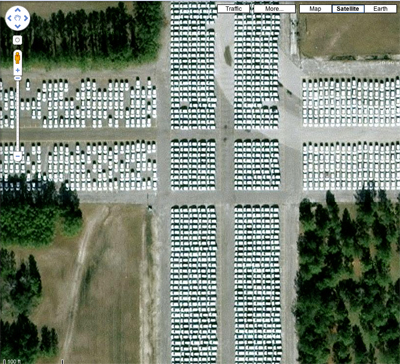 |
Rows of alledged UN vans for FEMA evacuation |
The petro-chemical-military-industrial complex is gassing Gulf Coast residents with poisonous Benzene and Corexit dispersant at dangerously high levels in the largest U.S. domestic military operation to date. The military and FEMA are engaged in Emergency Plans for 36 urban areas from Texas to Florida due to the unstoppable Gulf oil volcano the size of Mt. Everest, as WMR reports, indicating evacuations. Some people are advised to relocate now. (See Parts III and IV)
Satellite imagery that Obama's administration withheld shows "under the gaping chasm spewing oil at an ever-alarming rate is a cavern estimated to be around the size of Mount Everest. This information has been given an almost national security-level classification to keep it from the public," writes Wayne Madsen.
Human suffering in the Gulf is increasing from the world's latest and largest toxic oil kill as BP lies and government remains silent about human health risks and associated military interventions. Most immediately damaging of the operation's withheld information pertains to toxins breathed since the explosion.
Southerners reporting illnesses with symptoms reflecting Benzene and Corexit poisoning have had to face some leaders suggesting the cause to be mental illness, "stress", while others, such as BP chief Tony Hayward, blamed the illness on rotten food.
Hayward is the guy who sold his £1.4 million shares in BP one month before the Gulf "spill." This in turn caused a collapse of value and a saving to him of over £423,000 when BP’s share price plunged after its predicted destruction in the gulf according to the Telegraph. (Since Hayward's pay package of £4 million a year had been insufficient, cashing out enabled him to pay off the mortgage on his family’s mansion in Kent.)
No monitors, no dispersant toxicity studies
Other life-risking withheld information is that chemicals released have not been monitored. WMR colleague John Caylor, a Gulf Coast resident, reported, "BP and the U.S. Environmental Protection Agency (EPA), which have stated that several hundred air quality monitors have been deployed around the Florida and Alabama coasts and have not detected any benzene levels that would be harmful to human health, are lying." (WMR, EPA and media lying about air monitors on Gulf coast, June 7-8, 2010)
A senior news source at WEAR-TV, ABC's affiliate in Pensacola told Caylor that "there are no air quality monitors that have been deployed along the coastal bays and inlets by either BP or the EPA. The station sent reporters out to check on the monitors and discovered they were non-existent." (Emphasis added)
"ABC News network out of New York and CNN are echoing the BP and Obama administration's lines that the air quality is being monitored and is perfectly safe," wrote Caylor. WWL TV reports monitors are being now used in south Louisiana. (See video #2 below)
 The spewing oil and dispersant chemicals are toxic enough for so many people to become ill, evacuation would be required, especially before a hurricane blows the lethal cocktail over more Southerners. Hurricane season 2010, anticipated to be highly active and strong, will bring the oil and ipersant chemicals further inland, impacting health of too many people to be ignored. Already, even mainstream news reports 70 people in Louisiana have been admitted to hospital with symptoms of toxic poisoning. New Orleans area officials have urged people without means to evacuate before a hurricane to register now.
The spewing oil and dispersant chemicals are toxic enough for so many people to become ill, evacuation would be required, especially before a hurricane blows the lethal cocktail over more Southerners. Hurricane season 2010, anticipated to be highly active and strong, will bring the oil and ipersant chemicals further inland, impacting health of too many people to be ignored. Already, even mainstream news reports 70 people in Louisiana have been admitted to hospital with symptoms of toxic poisoning. New Orleans area officials have urged people without means to evacuate before a hurricane to register now.
"Get a game plan now," WWL reported.
Corexit and Benzene Gulf gas combo effects
On May 1, two U.S. Department of Defense C-130 Hercules aircraft were employed to spray oil dispersant, Corexit EC9500A and Corexit EC9527A. Dispersant information, however, was "kept secret under competitive trade laws."
The stated purpose of using more chemicals on the chemical spill was "to break up the oil into tiny droplets that sink and can be more readily dispersed by ocean currents, to diminish the oil’s effect on sea life and shore habitats." (New York Times, BP and EPA Skirmish Over Oil Dispersant, May 24, 2010) Mother Nature's non-chemical, safe, effective bio-remediation method (see Youtube below) of disposing of the oil was dismissed. Safe and effective solutions for human and environmental survival are not part of the agenda.
Material Safety Data Sheets (MSDS) "Fact sheets" page for Nalco's Corexit has pdfs available for "Dispersant Type 1," Corexit 9500 (PDF); and "Dispersant Type 2," Corexit 9527A (PDF). Tom Philpott of Grist, who found that these product numbers matched those identified unofficially by his sources, writes,
"The data sheets for both products contain this shocker: 'No toxicity studies have been conducted on this product" -- meaning testing their safety for humans and both data sheets include the warning 'human health hazards: acute.'" (Emphasis added)
As Philpott reported, the MSDS for Corexit 9527A states
'excessive exposure may cause central nervous system effects, nausea, vomiting, anesthetic or narcotic effects,' and 'repeated or excessive exposure to butoxyethanol [an active ingredient] may cause injury to red blood cells (hemolysis), kidney or the liver.'
'"Prolonged and/or repeated exposure through inhalation or extensive skin contact with EGBE [butoxyethanol] may result in damage to the blood and kidneys.'"
The solvents 2-Butoxyethanol and petroleum distillate appear "most dangerous," writes Philpott, but these chemicals continue to be saturating water and air.
Out of work shrimper, oil clean-up work Clint Guidry reported, “The closest I got [to the Gulf water] was Venice, Louisiana, and you could smell it from Venice... they were actually spraying Corexit 9527A on the oil spill on top of the water and spraying all around - Venice sits on a peninsula, the Mississippi River, right at the - right above the Head of the Passes.
"And they were actually spraying this Corexit in the air all around where people were living, with kids and children, and continuously saying how safe it was."
By May 24, New York Times reported that 700,000 US gallons (2,600,000 l) of Corexit dispersants had gassed the area, "approaching a world record." BP was ordered to take “immediate steps to scale back the use of dispersants" that the military was reportedly spraying. Both entities seemingly follow orders from a higher command. Chemical gassing of Gulf life continued.
Benzene, or "swamp gas," the toxin released by fossil fuel oil, is lethal enough for public health concern and action without Corexit. The International Agency for Research on Cancer (IARC) has determined that benzene causes severe human injury such as chromosomal, and is a human carcinogen. Exposure to high levels of benzene is associated with leukemia cancer: acute myelogenous leukemia, acute lymphocytic leukemia, and chronic myelogenous leukemia. (See: 0.9977 Benzene (IARC Summary & Evaluation, Supplement7, 1987)
Benzene-related leukemias have been reported to develop in as short as nine months according to IARC.
The satiation of toxic air, water and food has posed serious health risks to all people of the Gulf, but especially to pregnant women, the elderly and people with health vulnerabilities such as asthma and emphysema. Gina Solomon, NRDC Senior Scientist outlined health risks Louisianians and other Gulf Coast residents face.
Only days after BPs greatest oil assault began, Solomon recommended that pregnant women leave the oil spill area since fossil fuel oil toxins cause miscarriages.
Oil spill VOC (volatile chemicals) acute health effects include "headaches, dizziness and nausea," and "[o]ver the long term, many of these chemicals have been linked to cancer, so there are lots of reasons to worry about inhaling them," advised Solomon. (Dupre, Hitting rock bottom calls for intervention, Examiner, May 9, 2010) The first nine Gulf spill workers were hospitalized for "dizziness, headaches and nausea" as Solomon predicted weeks before according to VOC effects, plus shortness of breath and nosebleeds, likely symptomatic of Corexit.
Adding fire to the fuel, burning the slick as the petrochemical-military-industrial complex are also doing, has compounded the public health risk. Dr. Marcel Casavant, chief of Pharmacology and Toxicology at Nationwide Children’s Hospital in Columbus, Ohio, has stated, "Smoke from burning oil contains many chemicals; some are potentially lethal poisons...” (ABC News, BP Gulf Oil Spill: Human Health Risks Small But Fears May Linger) Casavant indicates those at greatest risk are children.
Oil toxic poisoning does not always have immediate impact. One study showed that the effect is generational: women exposed to oil toxins have daughters with reproductive health problems, such as miscarriages. (See: Dupre, FUEL DVD countdown to end old, dirty, dangerous, corrupt business, Examiner, May 11. 2010; and Josh Tickell, FUEL, 2009)
Within days of the Gulf incident, the smell of oil was so strong in coastal deep south, it was reported that one lady had to shut all her windows, turn on her AC and "if her asthma keeps up like this, she'll need to go on her breathing machine tonight." Meanwhile, police were driving up and down the beach "explicitly telling tourists to 'just stay out of the water.'" (It's BP's Oil, Mother Jones, May 24, 2010) That was almost a month ago. How is she now?
Harassed for attempted survival
CNN reported that commercial shrimper working on the "clean-up," John Wunstell Jr. filed a temporary restraining order in federal court against BP to stop its harassment of workers that voice health concerns. He "wants the oil giant to give the workers masks." Among first reported workers hospitalized for oil/gas injury, Wuntsell alleges that BP confiscated his clothing stripped from him in the hospital, and told him that they would not be returned. This story is eerily similar to those of Nazi gas chambers.
Louisiana Shrimpers Association also accused BP of threatening to fire fisherman from cleanup jobs if they complain about health problems or wear masks. (See Gulf Spill Workers Hopsitalized, Restraining Orders sought, News Inferno) Clean-up worker fishermen were not given respirators, "not even those working in the most dangerous area, closest to the well still spewing oil into the Gulf of Mexico," reported Guidry.
Such negative public relations for corporatism has almost been blacked-out. Gulf Coast residents lack information about serious risks BP's poisons are inflicting on them. Solomon's words of warning were a silenced clarion call to Gulf residents.
Full story HERE

No comments:
Post a Comment